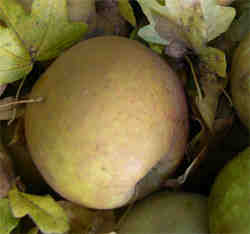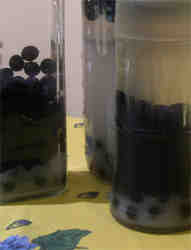Apple Chutney recipe
Posted by Fiona Nevile in Chutney and Pickles | 252 comments
Our apples make great chutney
I’m not surprised that the fruit that tempted Eve was an apple. It is such a useful fruit. From sweet apple puree to flagons of frothy cider, the apple plays a major role in our lives.
It always troubles me when I see apples left unpicked on trees. We’ve had a great cooking apple harvest this year. Danny and I have spent the morning picking apples from the old trees in our tiny orchard. We are going to make cider this year and have a go at apple wine. So we left a great pile of them on the garden table to soften in the frosts.
If you do this it’s easier to extract the juice. The ones that we pick from the tree are wrapped in newspaper and stored in cardboard boxes in the shed. The mice do nibble a few but the majority keep through the winter until we need them.
The windfalls don’t keep. Even if they look good they are bruised when they hit the ground. We have loads of windfalls, so we decided to branch out and add apple chutney to our range. As with our plum chutney we wanted a fruit rather than a vegetable taste.
This delicate chutney is the result.
| Cottage Smallholder Apple Chutney recipe |
- 1.5 k of cooking apples
- 500g of onions
- 500g of sultanas
- 750g Demerara sugar
- 500ml of white wine vinegar
- Zest and juice of two lemons
- I small chilli
- 1 tsp ground ginger
- 1 tsp ground allspice
- ½ tsp of cinnamon
- Pinch of ground cloves
- ½ tsp of Maldon sea salt
- 8 peppercorns
- 1 tbsp of mustard seed
- Wash, peel, core and chop the apples fine
- Peel and chop and mince the onions (if you don’t have a mincer chop them very fine)
- Put all ingredients into a large heavy bottomed saucepan and bring slowly to the boil. Stirring until the sugar is dissolved.
- Then simmer very gently, bubbles barely breaking the surface, until the chutney has thickened, stiring every now and then.
- It is ready when drawing a spoon across the surface leaves a definite track mark. This will take at least four hours.
- Pot into warm sterilised jars with plastic lined lids (how do I sterilise jars and lids? See Tips and Tricks below).
- Don’t use cellophane lids as the vinegar will evaporate through these and your chutney will dry up.
- Label when cold and store in a cool, dry place.
- Leave to mature for a month. The longer that you leave it to mature the better it will be!
Tips and Tricks
<strong>How do I get rid of tainted smells in pots?</strong>
If your cooking pot or container is tainted with the smell of the last resident (curry, tomato sauce etc). Sprinkle with a good tablespoon of bicarbonate of soda into it and add a good splosh of boiling water. Rub the solution over all surfaces and leave for two minutes. Rinse well in cold water.
<strong>How do I sterilise jars and lids?</strong>
The sterilising method that we use is simple. When the chutney is cooked, I quickly wash and rinse the jars and place them upside down in a cold oven. Set the temperature to 160c (140c fan assisted). When the oven has reached the right temperature I turn off the heat. The jars will stay warm for quite a while. I only use plastic lined metal lids for preserves as the all-metal lids can go rusty. I boil these for five minutes in water to sterilise them. If I use Le Parfait jars, I do the same with the rubber rings.
Leave a reply






I made a batch of this today – it’s lovely and deep colored and my house smells wonderful. I’m looking forward to having some with a smoky ham or crispy pork belly.
For those that are wondering, I got six 375ml jars full, with another generous dollop to pop in a container in the fridge for immediate use.
Thanks very much for the recipe – it’s a great way to use up some of the fruit from our very heavily laden trees!
this is the best chutney recipe ever and I make a lot of chutneys
The recipe requires 1 tbsp of mustard seed. Can I use dry mustard and what would be the equivalent measure of dry mustard?
I made this recipe with my glut of apples 2 years ago and we have just eaten the last jar of chutney made then. It tastes amazing! I can’t believe how long it has lasted (it has been in the fridge for the past year – in a cupboard before that). Am about to make it again with this year’s apples and will be patient before eating.
Hi Eileen, I too have noticed that the apple chutney I made with this FABULOUS recipe has crystalised a bit, but I don’t find it bothers me; it almost enhances the taste! It would be interesting, however, to understand why this happens sometimes.
Charlotte
Hi Fiona, I really like the apple chutney I made from your recipe in October 2012, but on opening the second jar, have found the chutney to be crystalised, – like grains of sugar. Have you any advice on what may have caused this?
Eileen
Ive been using this recipe for about 3years now, and it produces a gorgeous chutney with my little red crab apples!
Hi Fiona,
I made your fabulous apple chutney again this year, but in July, and left it in a dark, dry room where the temperature may have gone up to 30 degrees while I was away on holiday. Now I’ve noticed that half of the lids on the mason jars DO pop a little. I did NOT boil the jars after sealing them as I do when making jam. Do you think I have to throw out the jars with the “uncertain” lids? I would be so grateful for your advice. Many thanks. Charlotte
Hi Fiona,
I made your amazingly good apple chutney again this year, but this time in July, and left it in a dry, dark room, covered with a dish towel over the summer. The problem is that the temperature probably went up to 30 degrees when I was on holiday, and now I’ve noticed that half the lids on the mason jars DO pop a little. Do you think the chutney suffered the heat and I have to ditch those jars with the uncertain lids? I did NOT boil the jars after sealing them (as I do with jam). I would appreciate your advice immensely. Many thanks.
No comments about the Beer then anybody?